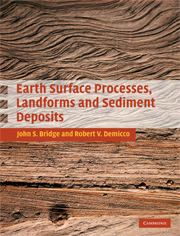Book contents
- Frontmatter
- Contents
- Acknowledgments
- Figure credits
- PART 1 Introduction
- PART 2 Production of sediment at the Earth's surface
- PART 3 Fundamentals of fluid flow, sediment transport, erosion, and deposition
- 5 Unidirectional turbulent water flow, sediment transport, erosion, and deposition
- 6 Air flow, sediment transport, erosion, and deposition
- 7 Multidirectional water flow, sediment transport, erosion, and deposition
- 8 Movement of sediment by gravity
- 9 Generation and movement of volcaniclastic sediment
- 10 Ice flow, sediment transport, erosion, and deposition
- 11 Biogenic and chemogenic depositional structures
- 12 Post-depositional deformation of soft sediment
- PART 4 Environments of erosion and deposition
- PART 5 Sediment into rock: diagenesis
- PART 6 Long-term, large-scale processes: mountains and sedimentary basins
- References
- Appendix: Methods of study of Earth surface processes, landforms, and sediments
- Index
- Plate section
10 - Ice flow, sediment transport, erosion, and deposition
from PART 3 - Fundamentals of fluid flow, sediment transport, erosion, and deposition
Published online by Cambridge University Press: 05 June 2012
- Frontmatter
- Contents
- Acknowledgments
- Figure credits
- PART 1 Introduction
- PART 2 Production of sediment at the Earth's surface
- PART 3 Fundamentals of fluid flow, sediment transport, erosion, and deposition
- 5 Unidirectional turbulent water flow, sediment transport, erosion, and deposition
- 6 Air flow, sediment transport, erosion, and deposition
- 7 Multidirectional water flow, sediment transport, erosion, and deposition
- 8 Movement of sediment by gravity
- 9 Generation and movement of volcaniclastic sediment
- 10 Ice flow, sediment transport, erosion, and deposition
- 11 Biogenic and chemogenic depositional structures
- 12 Post-depositional deformation of soft sediment
- PART 4 Environments of erosion and deposition
- PART 5 Sediment into rock: diagenesis
- PART 6 Long-term, large-scale processes: mountains and sedimentary basins
- References
- Appendix: Methods of study of Earth surface processes, landforms, and sediments
- Index
- Plate section
Summary
Introduction
Approximately 10% of the Earth's surface is covered with ice today, most of which is in the East and West Antarctic ice sheets. The present area of the Antarctic ice sheets is approximately 11.5 million square kilometers, its volume is about 26 million cubic kilometers, and its maximum thickness is about 4 km. These Antarctic ice sheets contain more than 90% of the Earth's ice and about 75% of the Earth's freshwater. Despite the coldness of the Antarctic climate, large lakes (e.g., Lake Vostok) have recently been discovered underneath the Antarctic ice. The other main ice accumulation is on Greenland, with an area of about 1.7 million square kilometers, a volume of about 2.7 million cubic kilometers, and a maximum thickness of about 3.4 km. The Greenland ice sheet contains about 7% of the Earth's freshwater. The remainder of the ice on the Earth, only 3% by area, is in small ice caps and valley glaciers in mountainous regions. In addition to the areas of permanent ice, about 20% of the Earth's surface is affected by permafrost, i.e., permanently frozen.
Permanent ice requires abundant precipitation as snow and temperatures low enough to permit the snow to accumulate. These conditions occur at high latitudes and/or high altitudes. The lower limit of permanent snow and ice (the snowline) is at sea level in polar regions, but is at an elevation of 3 km in the temperate Alps, and at 6 km in the equatorial Andes.
- Type
- Chapter
- Information
- Earth Surface Processes, Landforms and Sediment Deposits , pp. 292 - 310Publisher: Cambridge University PressPrint publication year: 2008



